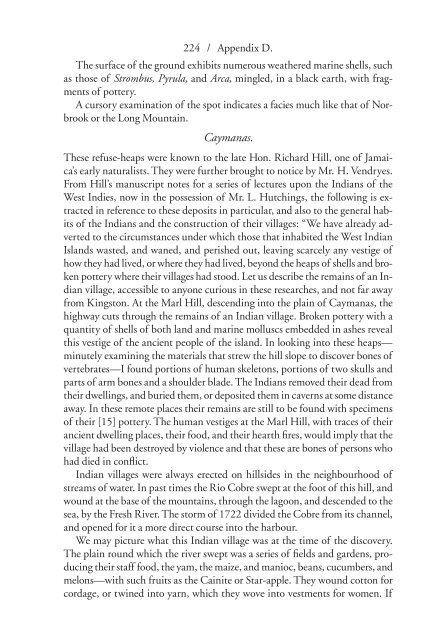Pre-Colombian Jamaica: Caribbean Archeology and Ethnohistory
by Phillip Allsworth-Jones
by Phillip Allsworth-Jones
Create successful ePaper yourself
Turn your PDF publications into a flip-book with our unique Google optimized e-Paper software.
224 / Appendix D.<br />
The surface of the ground exhibits numerous weathered marine shells, such<br />
as those of Strombus, Pyrula, <strong>and</strong> Arca, mingled, in a black earth, with fragments<br />
of pottery.<br />
A cursory examination of the spot indicates a facies much like that of Norbrook<br />
or the Long Mountain.<br />
Caymanas.<br />
These refuse- heaps were known to the late Hon. Richard Hill, one of <strong>Jamaica</strong>’s<br />
early naturalists. They were further brought to notice by Mr. H. Vendryes.<br />
From Hill’s manuscript notes for a series of lectures upon the Indians of the<br />
West Indies, now in the possession of Mr. L. Hutchings, the following is extracted<br />
in reference to these deposits in particular, <strong>and</strong> also to the general habits<br />
of the Indians <strong>and</strong> the construction of their villages: “We have already adverted<br />
to the circumstances under which those that inhabited the West Indian<br />
Isl<strong>and</strong>s wasted, <strong>and</strong> waned, <strong>and</strong> perished out, leaving scarcely any vestige of<br />
how they had lived, or where they had lived, beyond the heaps of shells <strong>and</strong> broken<br />
pottery where their villages had stood. Let us describe the remains of an Indian<br />
village, accessible to anyone curious in these researches, <strong>and</strong> not far away<br />
from Kingston. At the Marl Hill, descending into the plain of Caymanas, the<br />
highway cuts through the remains of an Indian village. Broken pottery with a<br />
quantity of shells of both l<strong>and</strong> <strong>and</strong> marine molluscs embedded in ashes reveal<br />
this vestige of the ancient people of the isl<strong>and</strong>. In looking into these heaps—<br />
minutely examining the materials that strew the hill slope to discover bones of<br />
vertebrates— I found portions of human skeletons, portions of two skulls <strong>and</strong><br />
parts of arm bones <strong>and</strong> a shoulder blade. The Indians removed their dead from<br />
their dwellings, <strong>and</strong> buried them, or deposited them in caverns at some distance<br />
away. In these remote places their remains are still to be found with specimens<br />
of their [15] pottery. The human vestiges at the Marl Hill, with traces of their<br />
ancient dwelling places, their food, <strong>and</strong> their hearth fires, would imply that the<br />
village had been destroyed by violence <strong>and</strong> that these are bones of persons who<br />
had died in conflict.<br />
Indian villages were always erected on hillsides in the neighbourhood of<br />
streams of water. In past times the Rio Cobre swept at the foot of this hill, <strong>and</strong><br />
wound at the base of the mountains, through the lagoon, <strong>and</strong> descended to the<br />
sea, by the Fresh River. The storm of 1722 divided the Cobre from its channel,<br />
<strong>and</strong> opened for it a more direct course into the harbour.<br />
We may picture what this Indian village was at the time of the discovery.<br />
The plain round which the river swept was a series of fields <strong>and</strong> gardens, producing<br />
their staff food, the yam, the maize, <strong>and</strong> manioc, beans, cucumbers, <strong>and</strong><br />
melons— with such fruits as the Cainite or Star- apple. They wound cotton for<br />
cordage, or twined into yarn, which they wove into vestments for women. If


















